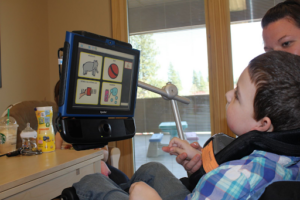
Augmentative and Alternative Communication, or AAC, is instrumental for effective, efficient, and successful communication, especially for those with communication and speech disorders. Myths surrounding AAC can prevent families, individuals, and even some therapists from supporting AAC usage. Here are some of the top myths about AAC and why these myths are indeed, just myths.
Myth: Use of AAC discourages or hinders verbal speech production
Perpetrators of this myth believe that AAC will cause individuals to lose interest in talking or that they will only want to use AAC to communicate. Research studies show that AAC does not have a negative impact on verbal language (Millar et. al, 2006). Rather, AAC can actually support and encourage verbal language development. AAC is also beneficial for all-around development, as it supports expressive language skills, receptive language skills, literacy skills, play skills, social and pragmatic skills, behavioral skills, and frustration tolerance (Light et al., 2003; Millar et al., 2006).
Myth: AAC is only for pre-verbal or non-verbal individuals
Although AAC is extremely beneficial for those who do not speak, it is not exclusively reserved for these individuals. The term “augmentative” (the first “A” in AAC) refers to the use of communication systems to supplement speech. If an individual has limited verbal speech or demonstrates decreased understandability, AAC can help them effectively communicate. For example, people with motor-speech disorders often demonstrate decreased understandability due to muscle weakness, muscle incoordination, and/or planning/sequencing difficulties of the muscles involved in speech production. Even though these individuals have the ability to speak, they benefit from AAC to supplement their message when they cannot be understood or when they do not have the capability to produce the desired message. “Alternative” (the second “A” in AAC) refers to the use of systems by individuals with no-verbal communication.
Even individuals with intact verbal communication skills use AAC on a daily basis, as AAC emcompasses all of the ways that we communicate outside of talking. Use of facial expressions, body language, texting, emailing, gestures (e.g, waving, holding a finger up to the lips to indicate “shhh”), holding up objects, pointing to pictures, and writing are just a few examples of everyday AAC systems.
Myth: Children must reach a certain age or have certain prerequisite skills to use AAC
There is no evidence to suggest that children must be a certain chronological age to use AAC. Rather, introducing AAC during infancy and toddlerhood can have a positive impact on a ch

ild’s brain development. The National Scientific Council on the Developing Child (2007) reported that enriching experiences during infancy and toddlerhood (such as using AAC) establishes foundations for later brain development, which helps improve a way a child thinks and regulates emotions.
There is also no evidence that children need certain prerequisite skills to use AAC. In the past, children with cognitive or sensorimotor impairments were often excluded from AAC usage due to absent foundational skills. However, children with cognitive and sensimotor impairments have been shown to effectively implement and use AAC, provided individualized support. Further, implementing AAC with children with cognitive or sensorimotor deficits can have a positive impact on their global development (Ganz et al., 2011; Ganz & Simpson, 2018; Kasari et al., 2014; O’Neill, Light, & Pope, 2018; Romski et al., 2010; Walker & Snell, 2013). AAC can also enable children to demonstrate their cognitive abilities, especially in those who do not yet speak or have a reliable way to communicate.
In short, no matter a child’s age or ability level, AAC promotes brain development and provides a way for a child to improve in a variety of developmental areas.
Myth: You must have good motor skills to use a speech-generating AAC device.
As stated above, there are no prerequisites for using AAC. Just as there are many different types of AAC systems, there are also a variety of ways to activate these systems. For individuals with significant motor impairments, eye gaze technology (using equipment to track eye movements) and switch scanning (activating a switch using a specific body part) are two of the most widely used access options. One of the most famous scientists of the 21st century, Dr. Stephen Hawking, lost voluntary muscle control

throughout the majority of his body due to ALS. He activated his AAC speech-generating device using his thumb, then a switch mounted to his glasses, which picked up on small movements in his cheeks and face (DO-IT, 2021). Recently, researchers have helped completely paralyzed individuals activate AAC systems using just their breath and have even successfully found a way to activate devices using just the brain (Elsahar et. al., 2018; Moses et. al., 2021)
Individuals with vision, hearing, and other physical impairments are also able to access and use AAC systems, provided appropriate equipment and support. A team of professionals (occupational therapist, physical therapist, audiologist, vision specialists, etc.) should collaborate to help determine the best activation method for AAC based on an individual’s strengths and needs.
Myth: Children should start with low-tech AAC before moving on to high-tech AAC
Children do not have to demonstrate competence with a low-tech AAC system before moving toward a high-tech AAC system. (Don’t know the difference between low-tech and high-tech? Check out the previous blog post for more information!)
Since every child has different needs, strengths, skills, environments, and support systems, AAC should be selected based on those criteria, rather than a one-size-fits-all approach or progression. Further, since communication is most effective when it is multimodal, a combination of unaided systems, as well as aided low-tech and high-tech systems can be used in conjunction with one another to help provide the best functional communication outcomes.
A speech-language pathologist, as well as other healthcare professionals, can assist in the assessment, recommendation, and trialing of a variety of systems and modalities to determine the best fit for an individual. Even if a system is successful, modifications to the system or a replacement of the system may be necessary based on progress, changes, personal preferences, and other developmental factors. Flexibility, collaboration, and consistency is necessary for effective AAC interventions.
Questions or concerns?
If you have questions or concerns about your child’s communication skills, please contact us at info@playworkschicago.com or (773) 332-9493. The Speech-Language Pathology team and the Assistive Technology team are available to provide individualized AAC recommendations based on your child’s needs.
Nicole Sherlock, MA, CCC-SLP
Speech-language pathologist
Assistive Technology Co-Coordinator
Common myths about AAC (augmentative & alternative communication). Common myths about AAC (Augmentative & Alternative Communication) – Tobii Dynavox. (n.d.). https://www.tobiidynavox.com/learn/what-is-aac/common-questions/.
Elsahar, Y., Bouazza-Marouf, K., Kerr, D., Gaur, A., Kaushik, V., & Hu, S. (2018). Breathing Pattern Interpretation as an Alternative and Effective Voice Communication Solution. Biosensors, 8(2), 48. https://doi.org/10.3390/bios8020048
Ganz, J.B., Earles-Vollrath, T.L., Mason, R.A., Rispoli, M.J., Heath, A.K., & Parker, R.I. (2011). An aggregate study of single-case research involving aided AAC: Participant characteristics of individuals with autism spectrum disorders. Research in Autism Spectrum Disorders, 5, 1500–1509. doi:10.1016/j.rasd.2011.02.011
Ganz, J., & Simpson, R. (2018). Interventions for individuals with autism spectrum disorder and complex communication needs. Baltimore, MD: Paul H. Brookes.
Kasari, C., Kaiser, A., Goods, K., Nietfeld, J., Mathy, P., Landa, R., … Almirall, D. (2014). Communication interventions for minimally verbal children with autism: A sequential multiple assignment randomized trial. Journal of the American Academy of Child and Adolescent Psychiatry, 53, 635–646. doi:10.1016/j.jaac.2014.01.019
Light, J. C., Beukelman, D. R., & Reichle, J. (2003). Communicative competence for individuals who use AAC: From research to effective practice. Brookes Publishing.
Millar, D.C., Light, J.C., & Schlosser, R.W. (2006). The impact of augmentative and alternative communication intervention on the speech production of individuals with developmental disabilities: A research review. Journal of Speech, Language, and Hearing Research, 49(2), 248–264.
Neuroprosthesis for Decoding Speech in a Paralyzed Person with Anarthria. Moses DA, Metzger SL, Liu JR, Anumanchipalli GK, Makin JG, Sun PF, Chartier J, Dougherty ME, Liu PM, Abrams GM, Tu-Chan A, Ganguly K, Chang EF. N Engl J Med. 2021 Jul 15;385(3):217-227. doi: 10.1056/NEJMoa2027540. PMID: 34260835.
National Scientific Council on the Developing Child (2007). The Timing and Quality of Early Experiences Combine to Shape Brain Architecture: Working Paper #5. http://www.developingchild.net
O’Neill, T., Light, J., & Pope, L. (2018). Effects of interventions that include aided AAC input on the communication of individuals with complex communication needs: A meta-analysis. Journal of Speech Language and Hearing Research, 61, 1743–1765. doi:10.1044/2018_jslhr-l-17- 0132
Romski, M., & Sevcik, R. (2005). Augmentative Communication and Early Intervention. Infants & Young Children, 18(3), 174–185. https://doi.org/https://depts.washington.edu/isei/iyc/romski_18_3.pdf
Romski, M., Sevcik, R., Adamson, L., Cheslock, M., Smith, A., Barker, R., & Bakeman, R. (2010). Randomized comparison of augmented and nonaugmented language interventions for toddlers with developmental delays and their parents. Journal of Speech, Language, and Hearing Research, 53, 350–364. doi:10.1044/1092-4388(2009/08-0156)
University of Washington. (2021, April 9). Dr. Stephen Hawking: A Case Study on Using Technology to Communicate with the World | DO-IT. DO-IT: Disabilities, Opportunities, Internetworking, and Technology. https://www.washington.edu/doit/dr-stephen-hawking-case-study-using-technology-communicate-world
Myth: Young Children Must Wait Until They Can Use AAC. Tobii Dynavox (n.d.).
Photo by Volodymyr Hryshchenko on Unsplash
Photo by Stephen Andrews on Unsplash
Photo by Palle Knudsen on Unsplash
